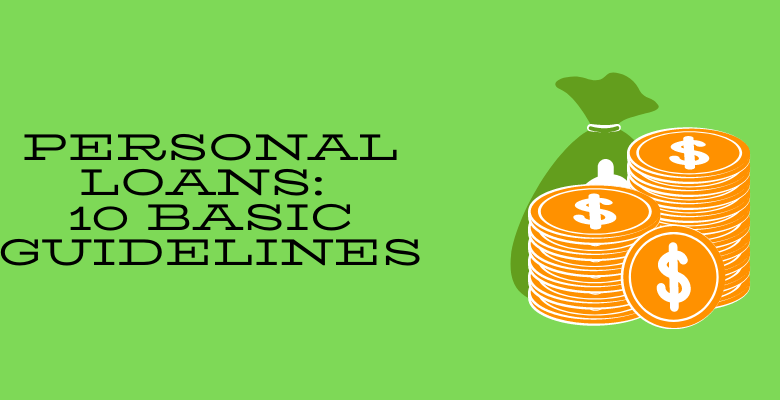Personal Loans: 10 Basic Guidelines

One of the most common types of loans taken out by people is a personal loan. The fact that lenders do not restrict or limit the final use of the cash granted with such loans, unlike with conventional loans, is a significant factor in their popularity. This implies that they can be put to any use the borrower sees fit.
The most frequent uses include funding family events like weddings and birthday celebrations as well as long – awaited vacations. These are also frequently used to pay down payments on properties or vehicles, as well as for home improvements or furniture for the inside.
But in order to get the greatest deal on a personal loan, a borrower must be aware of and adhere to a few regulations.
Figure out the interest rate:
Potential borrowers can considerably benefit from conducting prior research on personal loan interest rates, terms, and conditions by visiting the websites of various lenders. The best options can also be found by using simple personal loan EMI calculator that are readily available online.
Choose a lender carefully after detailed study and proper research:
While personal loans are offered by banks, NBFCs (non-banking finance companies), and an expanding number of fintech businesses, the terms and conditions vary between conventional banks and the new fintech natives. Even if banks and NBFCs claim to give loans at reduced interest rates. Some borrowers may not be able to accept certain terms and conditions due to standards. Additionally, other lenders might have a better offer. It can also be a smart idea to compare the loan’s terms, together with the interest rates and fees, using an internet aggregator.
Maintain a high credit score:
Since personal loans are an unstructured type of credit, lenders will review an applicant’s credit score before accepting one, as this reflects the borrower’s creditworthiness. A score of 750 is typically regarded as excellent because credit ratings can vary from 300 to 900. Loans with low credit scores may be denied or granted with higher interest rates. Regular or prompt payment of credit card bills and EMIs can significantly contribute to keeping a good credit score.
Choose short-term loans:
Due to cheaper EMIs, borrowers may be readily tempted by loans with longer terms. However, because the unpaid balance would continue to accrue interest each month. Such loans will result in larger payback over the whole term. The sum is kept under control using short-term personal loans. Additionally, personal loan calculators assist in selecting the ideal alternatives.
Ensure timely payments:
Maintaining a good credit history and avoiding late fees and other penalties are both made possible by consistent and regular repayments. A negative remark could also reduce the likelihood of a future loan approval.
Avoid contacting multiple lenders:
Approaching numerous lenders at once may not be advantageous for the borrower because it can result in multiple queries. It gives the impression that the borrower is in a desperate situation for credit, which may not be positive and make lenders reluctant to issue credit. It is therefore advisable to look up and assess the eligibility requirements of various lenders. Then contact only those where the requirements are satisfied.
Read the fine print:
Any hidden fees, such as processing fees, late payment fees, or other embedded fees that could raise the total outflows must be disclosed by the borrower. If there are, set aside money for them or find a means to prevent them.
Foreclosure charges:
Foreclosure or prepayment fees are a few additional important factors to consider when choosing a lender. Sometimes borrowers are able to prepay a loan, but other factors, such as foreclosures or prepayment penalties, make it unwise. To avoid future disappointments, one must ascertain the necessary information in advance or choose lenders who do not ask for prepayment.
Avoid 0% EMI plans:
In partnership with lifestyle or retail companies, several lenders frequently entice customers with 0% EMI plans. As hefty file costs and processing fees for such programs are sometimes disclosed to borrowers only at the last minute, borrowers frequently find themselves paying interest.
Avoid Advance EMIs:
By effectively increasing interest rates, advanced EMIs cause borrowers to pay more than what is specified. During loan disbursement, some lenders could require borrowers to pay advance EMIs. It is wise to choose lenders or personal loan apps that simply require regular payments and to stay away from advanced EMIs.
Conclusion
It is advised to wait at least six months before reapplying if a lender rejects your loan application. If your credit score played a role in the decision to reject you. Aim to raise it during the next six months by making any unpaid bills. Applying to more lenders after rejection may be fruitless and result in further drops in your credit score from repeated rejections, which are never good.
The best course of action is to purchase loan protection insurance. Which covers your liability in the event of an unforeseen event that can force your family to shoulder the debt. Many banks provide insurance to cover terrible events including losing your job, accidents, disability, and fatalities.
Applying for the proper amount of loan is a crucial component. The total amount of loans should ideally be determined by how much you can safely pay back in the future. Therefore, before selecting how much to borrow, evaluate your demands and estimate your expenses.




